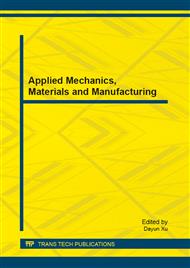[1]
Z. -H. Hu. A hybrid system based on neural network and immune co-evolutionary algorithm for garment pattern design optimization, Journal of Computers, 4 (11), (2009) pp.1151-1158.
DOI: 10.4304/jcp.4.11.1151-1158
Google Scholar
[2]
J. Zhang, G. Baciu and S Liang. A creative try: Composing weaving patterns by playing on a multi-input device, Proceedings of the ACM Symposium on Virtual Reality Software and Technology, VRST. (2010).
DOI: 10.1145/1889863.1889890
Google Scholar
[3]
Z. Penava, T. Sukser., and D. Basch Computer aided construction of reinforced weaves using matrix calculus, Fibres and Textiles in Eastern Europe, 76( 5), (2009), pp.43-48.
Google Scholar
[4]
N. Ahmad, T. Tanaka and Y. Saito Optimization of multipass turning parameters by genetic algorithm, Advanced Materials Research, Vol. 264-265, (2011)., pp.1545-1550.
DOI: 10.4028/www.scientific.net/amr.264-265.1545
Google Scholar
[5]
X.A. Yang, G.L. Sun, and H. Chen, X.H. Liu and W.S. Zhang. Research on design method of electromechanical product form based on MA-GA, School of Science, Chang'an University, South Er Huan Road, Xi'an, 710064, China; email: yang5336@126. com. cn, Copyright 2011 Elsevier B.V., All rights reserved. (2011).
Google Scholar
[6]
M. Salehi and R. Tavakkoli-Moghaddam. Application of genetic algorithm to computer-aided process planning in preliminary and detailed planning, Engineering Applications of Artificial Intelligence, 22(8), (2009), pp.1179-1187.
DOI: 10.1016/j.engappai.2009.04.005
Google Scholar
[7]
Z. Chen (2005), Fashion clothing supply chain management, Britain to China, Textile Asia, Vol. 36, , pp.53-56.
Google Scholar
[8]
I.M. Deiab and M.D.R. Al-Ansary. GA based optimization of manufacturing cycle cost, Proceedings of the IASTED International Conference on Modelling and Simulation , (2007), pp.532-537.
Google Scholar
[9]
Z. Chen Fashion clothing supply chain management, Britain to China, Textile Asia, Vol. 36, (2005), pp.53-56.
Google Scholar
[10]
D. Ujević, D. Rogale and D. Tržić. Development and application of computer support in garment and technical textile manufacturing processes, Tekstilec, Vol. 51, (2002), pp.224-229.
Google Scholar
[11]
H. Rödel, S. Krzywinski, A. Schenk andC. Herzberg. Links between design, pattern development and fabric behaviours for cloths and technical textiles, Tekstilec, Vol. 44, (2001), pp.197-202.
DOI: 10.1108/eum0000000005782
Google Scholar
[12]
Y. Cho, N. Okada, H. Park, M. Takatera, S. Inui and Y. Shimizu. An interactive body model for individual pattern making, International Journal of Clothing Science and Technology, Vol. 17, (2005), pp.100-108.
DOI: 10.1108/09556220510581236
Google Scholar
[13]
M.J. Denton and A.K. Seth. Computer Simulation of the Appearance of Fabric Woven from Blended-fibre Yarns, Journal of Textile Institute, Vol. 80, (1989), pp.415-440.
DOI: 10.1080/00405008908658296
Google Scholar
[14]
S. Inui. A Computer Aided System Using a Genetic Algorithm Applied to Apparel Design, Sen'I Gakkaishi , 50(12), (1994), pp.593-598.
DOI: 10.2115/fiber.50.12_593
Google Scholar
[15]
D.E. Goldberg. Genetic Algorithms in Search, Optimization & Machine Learning, Addision-Wesley Publish Co., NY (1989).
Google Scholar


